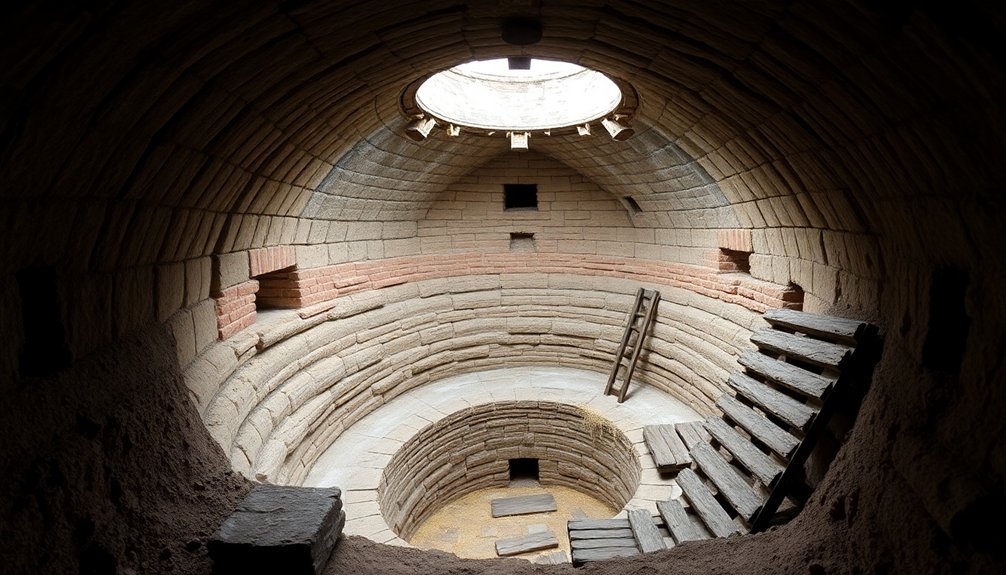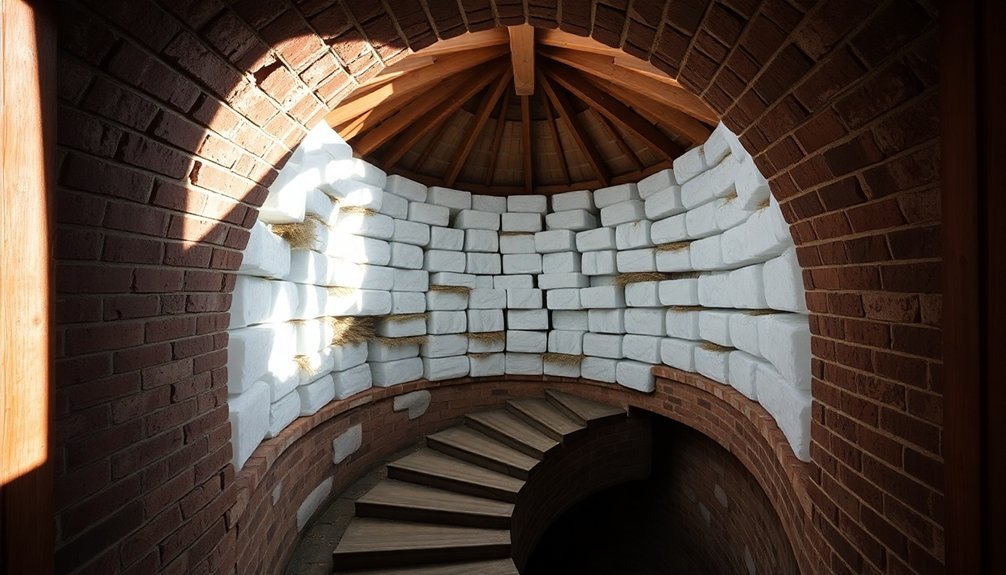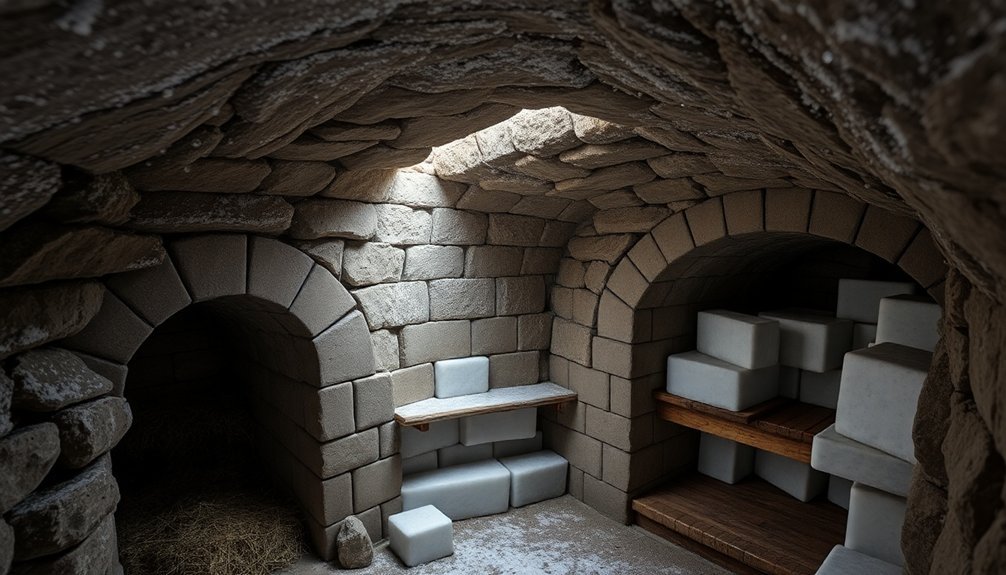Build your ice house on elevated, north-facing terrain to maximize natural cooling. You'll want thick stone or brick walls with sawdust-filled cavities for superior insulation, plus a cone-shaped design that minimizes heat absorption. Pack your ice blocks densely on wooden platforms above a gravel drainage layer, and don't forget proper ventilation to let warm air escape while keeping the cool air inside. These time-tested techniques helped ancient civilizations preserve food year-round, and they're still remarkably effective today. Discover how these proven methods can transform your approach to natural cold storage.
Smart Underground Design Principles

When designing an underground cold storage facility, proper site selection serves as the foundation for success. You'll want to choose an elevated, well-drained area on the north side of a hill to minimize sun exposure and shield against prevailing winds. Make sure you're close enough to your kitchen and ice source to maintain efficiency in daily operations.
Your structure should follow an inverted truncated cone shape, which reduces surface area and maximizes storage efficiency. Build thick walls using brick or stone, but don't use mortar until you're near the surface – this enhances structural stability. Double partitions filled with sawdust provide excellent insulation against heat transfer.
At the base, install coarse gravel to facilitate natural drainage and prevent water accumulation.
Don't overlook the importance of proper flooring. Install strong planks covered with wood shavings or sawdust for insulation, and design the floor to allow water to pass through without contacting the remaining ice.
If you're dealing with clay or stiff loam soils, you'll need to implement additional drainage measures. Consider covering your facility with an earthen mound or designing it as a domed temple to minimize visual impact while maintaining functionality.
Natural Insulation Material Secrets
Every successful cold storage facility relies on effective natural insulation to maintain consistent temperatures.
You'll find that traditional materials like sawdust, straw, and wicker have proven their worth over centuries of use. When properly packed, sawdust creates an exceptional barrier when tamped firmly between ice blocks and along walls, while straw excels as insulation between ceiling and roof spaces.
For modern applications, you'll want to take into account styrofoam as your primary insulator, installing it one foot thick under floors, around walls, and over ceilings. Rock wool offers a versatile alternative, providing excellent thermal protection while adding fire resistance and noise reduction benefits. Modern ice house designs with proper insulation lose under 10% ice annually.
If you're building with cavity walls, perlite and volcanic pumice work effectively as fill materials. You can maximize insulation effectiveness by incorporating double-wall construction with wide spaces for insulation material.
Don't forget to include proper ventilation channels to prevent moisture buildup. When selecting door insulation, verify it matches the thickness of your wall cavities.
For enhanced temperature control, think about adding a wrap-around porch to shield your walls from direct sunlight and maintain cooler interior temperatures.
Strategic Ice Block Placement

Building on proper insulation, the strategic placement of ice blocks becomes your next major focus in cold storage design. You'll need to pack ice densely, breaking it into manageable pieces and using heavy clubs to pound it into a solid mass. This consolidated structure considerably reduces the melting rate. Blocks of ice were routinely harvested from frozen ponds and lakes during winter months before electrical refrigeration existed.
| Key Element | Implementation Strategy |
|---|---|
| Block Support | Place wooden platforms or fence rails to elevate ice off ground |
| Drainage System | Install drains with gravel beneath for water runoff |
| Ventilation | Position vents to allow warm air escape while trapping cool air |
| Location Choice | Select north-facing, elevated sites away from direct sun |
Your ice house's structural integrity depends on thick stone walls and proper foundation design. You'll want to line these walls with insulating materials to prevent contact melting. Remember to maintain space between ice blocks and drainage gravel to allow proper water dispersal.
When positioning your ice house, consider both functionality and aesthetics. Choose a location that's convenient to your kitchen while remaining sheltered from prevailing winds. This placement strategy, combined with proper drainage and ventilation, creates an efficient cold storage system that maximizes ice preservation.
Frequently Asked Questions
How Long Did It Take to Manually Harvest Enough Ice for Storage?
You'll spend about 3-4 weeks harvesting ice during January's coldest days. With a team of workers and horses, you're able to cut, transport, and store enough ice blocks for year-round use.
What Cultures First Discovered the Art of Storing Ice Year-Round?
You'll find the earliest recorded ice storage in Mesopotamia around 1780 BC, though China had been practicing it before 1100 BC. The Persians later perfected year-round storage with their innovative yakhchāl system.
Did Ice Houses Serve as Community Gathering Places in Ancient Times?
While you can't be entirely certain, there's limited direct evidence of ice houses as community spaces. However, their architectural design and cultural importance in ancient Iran and China suggest they could've supported public gatherings.
How Much Did Ice Cost When Sold From Ancient Ice Houses?
You won't find exact prices from ancient ice houses, but you should know ice was a luxury item. Historical records from Rome show ice from pit bottoms cost more than surface snow.
What Alternative Uses Did Ice Houses Serve During Non-Winter Months?
You'll find ice houses served multiple purposes year-round: storing perishable foods, cooling drinks, functioning as community gathering spots, operating as convenience stores, and even providing emergency shelter during wartime or natural disasters.
In Summary
You'll find these ancient ice house principles remarkably relevant for modern cold storage. By applying smart underground design, using natural insulation materials, and strategically placing ice blocks, you can create an efficient cooling system that doesn't rely on electricity. Whether you're building a root cellar or planning sustainable cold storage, these time-tested techniques prove that sometimes the old ways work best.





Leave a Reply